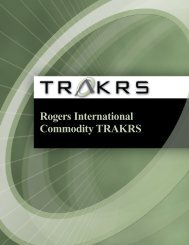The Inflation Cycle of 2002 to 2015 - Uhlmann Price Securities
The Inflation Cycle of 2002 to 2015 - Uhlmann Price Securities
The Inflation Cycle of 2002 to 2015 - Uhlmann Price Securities
Create successful ePaper yourself
Turn your PDF publications into a flip-book with our unique Google optimized e-Paper software.
Industrial Portfolio Strategy<br />
<strong>The</strong> <strong>Inflation</strong> <strong>Cycle</strong> <strong>of</strong> <strong>2002</strong> <strong>to</strong> <strong>2015</strong> ⎯ April 19, <strong>2002</strong> -50- Legg Mason Wood Walker, Inc.<br />
MMBtu, and in 2000 the average was $4.49/MMBtu. <strong>The</strong> average for the first 11 months <strong>of</strong> 2001 was<br />
$5.91/MMBtu, but prices in recent months have dropped below $4.00/MMBtu as the natural gas shortages<br />
<strong>of</strong> early 2001 have eased in the record warm winter <strong>of</strong> 2001/02.<br />
Asia has made extensive use <strong>of</strong> LNG where pipelines are not as feasible, but the capital investments<br />
for LNG are large. LNG is competitive in the U.S., but its greatest potential is in serving areas such as<br />
East Asia with very limited gas supplies and almost no pipeline infrastructure. LNG currently accounts for<br />
6% <strong>of</strong> the world’s natural gas consumption and 26% <strong>of</strong> cross-border gas flows. <strong>The</strong> largest importers <strong>of</strong><br />
LNG are the island nation <strong>of</strong> Japan (53% <strong>of</strong> the world <strong>to</strong>tal), South Korea (14%), France (8%) and Spain<br />
(6%), and the largest LNG exporters are Indonesia (29%), Algeria (19%), Malaysia (15%), and Qatar<br />
(10%). Well over 90% <strong>of</strong> Japan’s and South Korea’s natural gas supply is provided by LNG, and China is<br />
preparing <strong>to</strong> follow suit by building its own LNG terminals, beginning with a $600 million, 3 million metric<br />
<strong>to</strong>n per year terminal in Shenzhen (Guangdong Province) scheduled <strong>to</strong> be completed in 2005. Three million<br />
metric <strong>to</strong>ns is the equivalent <strong>of</strong> 146 billion cubic feet, or about 17% <strong>of</strong> China’s natural gas consumption in<br />
2000. <strong>The</strong> capital cost differential between LNG projects such as this and a planned $18 billion PetroChina<br />
gas development and pipeline project <strong>to</strong> connect Shanghai with western China gas resources, providing only<br />
three <strong>to</strong> five times as much gas as the Shenzhen LNG terminal, illuminates LNG’s attractiveness. <strong>The</strong> presence<br />
<strong>of</strong> some <strong>of</strong> the world’s largest known gas deposits in Irkutsk, Siberia, less than 2,000 miles from Beijing,<br />
creates another option for China in lieu <strong>of</strong> LNG, but such a pipeline requires many years <strong>to</strong> build.<br />
Canadian oil sands are another intriguing alternative supply option, but high capital costs and long<br />
project lead times hinder the growth potential for the next decade. In a remote section <strong>of</strong> Alberta, Canada<br />
lies a viscous mixture <strong>of</strong> sand, bitumen, clay and water with the consistency <strong>of</strong> cold molasses known as<br />
“oil sands,” which contains at least 300 billion barrels <strong>of</strong> economic reserves <strong>of</strong> oil, and <strong>to</strong>tal deposits (most<br />
<strong>of</strong> which are beyond current economic limits) <strong>of</strong> 1.7 trillion barrels <strong>of</strong> oil. <strong>The</strong> presence <strong>of</strong> 300 billion barrels<br />
<strong>of</strong> recoverable oil reserves — greater than the 262 billion barrels <strong>of</strong> proved reserves in Saudi Arabia —<br />
in the oil sands <strong>of</strong> Alberta, Canada, is attracting substantial investment. Engineering News Record magazine<br />
estimates that there are now 34 oil sands projects either planned or under construction, with a <strong>to</strong>tal cost <strong>of</strong><br />
U.S. $28.9 billion and 2.9 million barrels per day <strong>of</strong> planned oil production. <strong>The</strong> new planned or in-process<br />
projects detailed by ENR average $10,000 <strong>of</strong> capital investment per barrel per day <strong>of</strong> oil production, compared<br />
with $5,500 for Persian Gulf OPEC nations, so we believe their construction is more likely <strong>to</strong> occur<br />
on schedule if oil prices inflate. Of the new capacity for which extraction methods are known, 80% use<br />
truck-and-shovel mining, which is a key potential market for Joy Global’s shovels and Caterpillar’s mining<br />
trucks, while 20% use in-situ (drilling) extraction. To put the oil sands in perspective, however, the incremental<br />
oil supply that would be provided by 2010 if all <strong>of</strong> the known projects are completed represents<br />
only 8% <strong>of</strong> our forecast <strong>of</strong> incremental growth in world oil demand over that period. Like LNG<br />
projects, investment in the oil sands requires very long lead times and high capital investments. Some<br />
planned projects will not begin oil production until 2010, so they will have little ability <strong>to</strong> influence oil<br />
prices over the next decade, in our view. However, the decline in production costs and the location in a secure<br />
non-OPEC location ensure that oil sands production will attract investment in the coming years if our<br />
thesis is correct.<br />
<strong>The</strong> security <strong>of</strong> OPEC oil supply, which has implications for supply, demand, and substitutes within the energy<br />
markets, is an issue we address later in this report. But next, we discuss the outlook for agricultural<br />
commodities, which are driven by many <strong>of</strong> the same global supply and demand fac<strong>to</strong>rs as oil, and consume<br />
substantial energy in their production.








